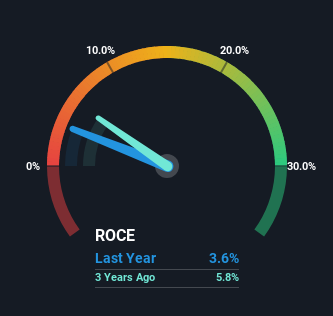Finding a business that has the potential to grow substantially is not easy, but it is possible if we look at a few key financial metrics. Amongst other things, we'll want to see two things; firstly, a growing return on capital employed (ROCE) and secondly, an expansion in the company's amount of capital employed. Put simply, these types of businesses are compounding machines, meaning they are continually reinvesting their earnings at ever-higher rates of return. In light of that, when we looked at Fuji Oil (TSE:2607) and its ROCE trend, we weren't exactly thrilled.
We've discovered 1 warning sign about Fuji Oil. View them for free.Understanding Return On Capital Employed (ROCE)
If you haven't worked with ROCE before, it measures the 'return' (pre-tax profit) a company generates from capital employed in its business. To calculate this metric for Fuji Oil, this is the formula:
Return on Capital Employed = Earnings Before Interest and Tax (EBIT) ÷ (Total Assets - Current Liabilities)
0.036 = JP¥12b ÷ (JP¥565b - JP¥224b) (Based on the trailing twelve months to December 2024).
Thus, Fuji Oil has an ROCE of 3.6%. Ultimately, that's a low return and it under-performs the Food industry average of 6.8%.
Check out our latest analysis for Fuji Oil

In the above chart we have measured Fuji Oil's prior ROCE against its prior performance, but the future is arguably more important. If you're interested, you can view the analysts predictions in our free analyst report for Fuji Oil .
So How Is Fuji Oil's ROCE Trending?
On the surface, the trend of ROCE at Fuji Oil doesn't inspire confidence. Over the last five years, returns on capital have decreased to 3.6% from 6.8% five years ago. Although, given both revenue and the amount of assets employed in the business have increased, it could suggest the company is investing in growth, and the extra capital has led to a short-term reduction in ROCE. And if the increased capital generates additional returns, the business, and thus shareholders, will benefit in the long run.
While on the subject, we noticed that the ratio of current liabilities to total assets has risen to 40%, which has impacted the ROCE. Without this increase, it's likely that ROCE would be even lower than 3.6%. Keep an eye on this ratio, because the business could encounter some new risks if this metric gets too high.
The Bottom Line On Fuji Oil's ROCE
Even though returns on capital have fallen in the short term, we find it promising that revenue and capital employed have both increased for Fuji Oil. And the stock has followed suit returning a meaningful 41% to shareholders over the last five years. So while investors seem to be recognizing these promising trends, we would look further into this stock to make sure the other metrics justify the positive view.
If you want to continue researching Fuji Oil, you might be interested to know about the 1 warning sign that our analysis has discovered.
For those who like to invest in solid companies, check out this free list of companies with solid balance sheets and high returns on equity.
New: AI Stock Screener & Alerts
Our new AI Stock Screener scans the market every day to uncover opportunities.
• Dividend Powerhouses (3%+ Yield)
• Undervalued Small Caps with Insider Buying
• High growth Tech and AI Companies
Or build your own from over 50 metrics.
Have feedback on this article? Concerned about the content? Get in touch with us directly. Alternatively, email editorial-team (at) simplywallst.com.
This article by Simply Wall St is general in nature. We provide commentary based on historical data and analyst forecasts only using an unbiased methodology and our articles are not intended to be financial advice. It does not constitute a recommendation to buy or sell any stock, and does not take account of your objectives, or your financial situation. We aim to bring you long-term focused analysis driven by fundamental data. Note that our analysis may not factor in the latest price-sensitive company announcements or qualitative material. Simply Wall St has no position in any stocks mentioned.
About TSE:2607
Fuji Oil
Manufactures and sells food and processed soybean ingredients in Japan, the Americas, Europe, Southeast Asia, and China.
Fair value with moderate growth potential.
Similar Companies
Market Insights
Community Narratives




